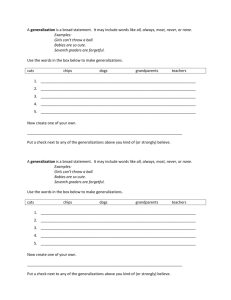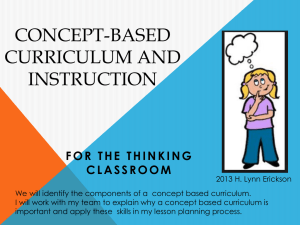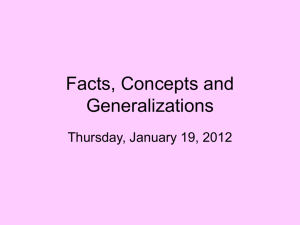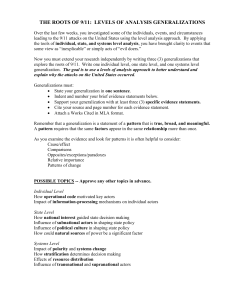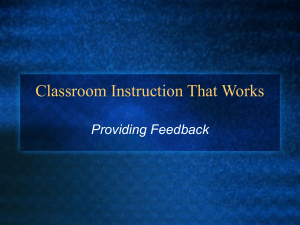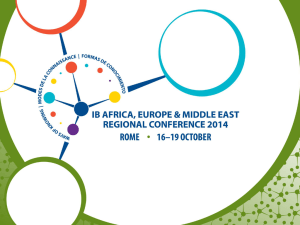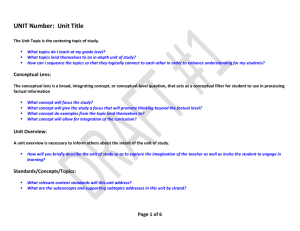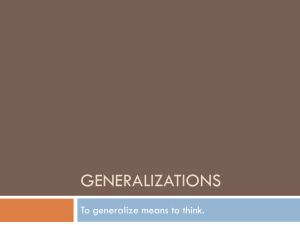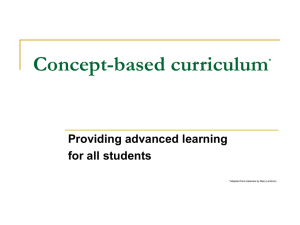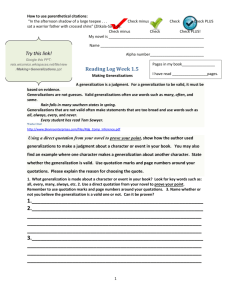1 Participant Copy - Day 2
advertisement
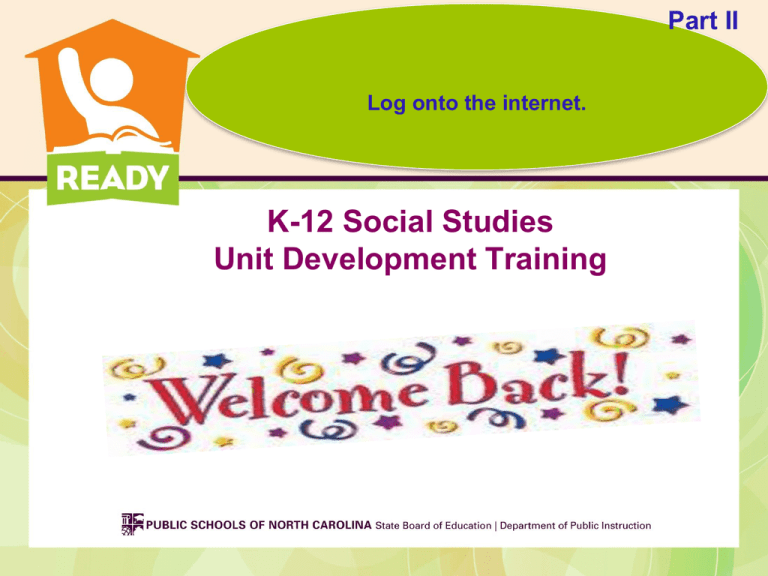
Part II Log onto the internet. K-12 Social Studies Unit Development Training Part II: Purpose & Expected Outcomes You will be able to: Develop generalizations to support a unit. Make modifications to strengthen generalizations. Write guiding questions that lead students to inductively arrive at the generalizations. Learn how to develop performance tasks to assess understanding. Identify the non-negotiable components of effective concept-based instruction. Determine next steps for your district/school to begin designing concept-based units of instruction. Guiding/Essential Questions • Guide student thinking through the factual material to inductively arrive at the generalization • Can be factual, conceptual, or provocative (debatable) • Engages student interest and intellect • Promotes discussion and debate • Promotes inquiry • Each generalization should have 3-5 questions • A unit may have 2-3 provocative questions for the entire unit. Factual Questions Locked in time, place, or situation Conceptual Essential Questions These questions can transfer over time and space. Provocative Essential Questions These questions have no right or wrong answer and should stir debate. An Example – Kindergarten Unit Topic: Who are we? Generalizations: Who we are is shaped by our culture and can change over time. 1. What is a timeline? (F) Conceptual Lens: 2. How does environment impact culture? (C) Culture and Change 3. Is it important to always be the same as everybody else ? (P) Unit Overview: 4. What is the relationship between environment, culture, and community? (C) Who we are is ultimately a reflection of where we come from, what we are raised with, and the experiences that change our lives. In this unit, students will learn about the factors that shape their young lives and the ways that people, places, and things can change over time, remaking who we are. 5. How is your culture the same as and different from other people’s culture? (F) 6. What are some ways that people can change who they are? (F) An Example – 6th Grade Unit Topic: Historical Foundations of Contemporary Societies Conceptual Lens: Patterns and Influence Generalizations: Exploration, innovations, and inventions often bring regions into contact with one another and result in the movement of people, goods, and ideas. 1. What innovations and ideas enabled European nations to engage in trans-Atlantic exploration? (F) 2. In what ways can economic goals affect government actions and individual rights? (C) 3. What is the economic impact of emigration on a society? (C) Unit Overview: A variety of factors influence the way that people lived and interacted in the past. Events and ideas from the past continue to shape contemporary societies. Those events and ideas often form patterns that help us understand not only the past, but the present as well. In this unit we will examine the historical foundations of contemporary societies around the world. 4. In what ways does demand for natural resources fuel exploration? (C) 5. Why was gold such a desirable resource for nations of Europe during the Age of Exploration? (F) 6. How is the need for oil affecting the way that nations in South America and Europe participate in the global economy? (F) Unit Topic: An Example – AH2 Everybody Wants To Rule The World *Note: The content of this unit is the Cold War and Its Effects. Generalization: Democratic governments seek public support and use propaganda to influence issues of national security and domestic policy issues and debates. 1. In what ways did the U.S. use emotional response to generate public support for the search for communists and anarchists in American government? (F) 2. How might fear affect political or government action? (C) 3. Is the restriction of civil liberties ever justified? (P) 4. How have both the Red Scare and the Patriot Act impacted the constitutional rights of U.S. citizens? (F) Conceptual Lens: Power & Conflict Unit Overview: This unit will focus on the elements of the foreign policy known as containment and the major conflicts that shaped the Cold War. Students will begin to look at how containment affected domestic policy and American life as well as the U.S. position as a power in the global world. 8 Steps 8-9 Assessing for Understanding Step 10 Begin with the end in mind (KUD) and work toward assessing for understanding. • Identify the desired results (KUD – Know/Understand/Do). • Design meaningful performance tasks that meet critical KUD’s. • Develop effective criteria to evaluate the results. U K D Developing The Performance Tasks Performance Tasks: Provide students with opportunities to actively demonstrate understanding of concepts, generalizations and content in the standards and unit. Student Performances: • Reflect the most important Understand (Generalizations), Know (Factual Knowledge), and Able to Do (Skills) of the unit. • Student Performances are the assessment evidence of mastery. Student Performances are not simple “activities.” The Components To Developing Performance Tasks Performance Task Template [What] Topic [Why] Generalization(s) [How] Student Performance Here’s A Performance Task Example What: As one of a team of cultural anthropologists, analyze the interactions of the early European settlers and American Indians. Why: In order to understand that: Interaction between different groups ma lead to cultural diffusion. How: Research one aspect of early Native American Indian and European culture (history, arts, religion, government, daily living, land use...) before and after the interaction between the groups. Drawing from your research, write a case study describing the obvious impacts or influences that these merging cultures have had on each other over time. As one member of the anthropological team, present an insightful and powerful speech to the state historical society, using visuals or multi-media, detailing the positive and negative lessons to be learned from the historical study of merging cultures. WHAT:__(Unit Title)________ Why:__(Enduring Understanding(s)_____________ HOW:_Performance (RAFTS)___________________ R= Role A= Audience F =Format T= Topics S= Strong verbs and adjectives Developing Learning Experiences & Instruction Step 11 III. Implement the design in a lesson. Ask: What LEARNING EXPERIENCES and INSTRUCTIONAL STRATEGIES will enable students to achieve the desired results? What enabling KNOWLEDGE (facts & concepts) and SKILLS (processes, procedures, strategies) will students need in order to perform effectively and achieve desired results? What ACTIVITIES will equip students with the needed knowledge and skills? Developing Learning & Developing LearningExperiences Experiences Instruction 1. Determine the knowledge and skills that students will need to be successful in independently completing the Culminating Performance Task; then… 2. Design Student Learning Experiences to prepare students with the knowledge and abilities to be successful on the Culminating Task. 3. Do the Correlations of Student Learning Experiences, by number, to the GENERALIZATIONS, KNOW, and KEY SKILL components developed earlier in the unit. This correlation makes certain that the unit has coherence as well as adherence to what you want students to KNOW, UNDERSTAND, and be able to DO. Page 4 Suggested Learning Experiences/Instructional Activities 1. 2. 3. 4. 5. 6. 7. Research Skills Know cultural diffusion – other key concepts & voc. How to write a case study Expose them to various visuals with Public Speaking Skills Teach how to use multimedia presentations Teach how to use graphic organizers – especially using vocabulary Developing Learning Experiences Using the previous performance task, Make a list of learning experiences that a teacher will need to teach and students will need to learn in order to effectively complete the performance task. Planning Your Next Steps On the wiki, pull up these data documents • DPI Recommendations • Fidelity Check • Action Plan

